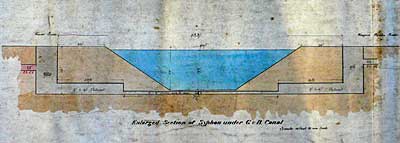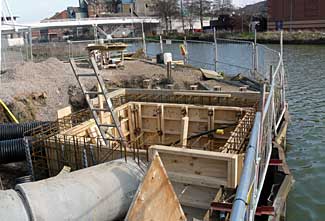Culvert
The
original culvert under the canal, about 110 yards south of the new
High Orchard Bridge, was built in the 1790s for the southern branch
of the Sudbrook known as the Still Ditch (or Tweenbrook) which drains
what became the Linden Road area of Gloucester. There was another
culvert for the northern branch of the Sudbrook on the line of High
Orchard Bridge. The two branches joined on the west side of the
canal and entered the River Severn just above the later Llanthony
Weir. A report in 1801 records that the southern branch was carried
under the canal by two 16 inch diameter cast-iron pipes and the
northern branch by one such pipe. (OS maps; TNA RAIL 829/4 p255)
Sewer
During the second
half of the nineteenth century, Gloucester expanded rapidly to the
south, and there was growing concern about providing proper drains
for the area. Thus in 1884-85, the existing culvert was incorporated
into a new sewer to serve the South End Drainage District. The sewer
followed the line of the stream from the one-mile milestone on the Bristol Road
through what were then timber yards to the culvert under the canal,
and then it took a new line direct to an outfall on the River Severn
just below the recently constructed Llanthony Weir. The plans for
the sewer show the two existing 16 inch pipes under the canal and
new access shafts on each side. (Glos Arch GBR L10/1/3)
line of the stream from the one-mile milestone on the Bristol Road
through what were then timber yards to the culvert under the canal,
and then it took a new line direct to an outfall on the River Severn
just below the recently constructed Llanthony Weir. The plans for
the sewer show the two existing 16 inch pipes under the canal and
new access shafts on each side. (Glos Arch GBR L10/1/3)
Redundant
In the 1950s
and 1960s, a major new sewerage system for Gloucester was constructed,
including a pumping station and treatment works at Netheridge, and
the sewer through the culvert became redundant. The vertical shafts
were capped with concrete and forgotten - until contractors preparing
to install a storm water outfall broke up the western cap and exposed
the shaft again.
 New Work New Work
The contractors found that the shaft
had been filled with concrete up to the invert of the outlet pipe
- which had also been plugged with concrete. They poured in some
reclaimed hardcore and some more concrete to form a foundation for
the chamber of the new storm water outfall that they had originally
set out to build. In due course, the chamber itself was constructed
on top of the foundation, and the picture shows the shuttering in
place ready for pouring the concrete. The outfall was eventually
completed in March 2008.
|